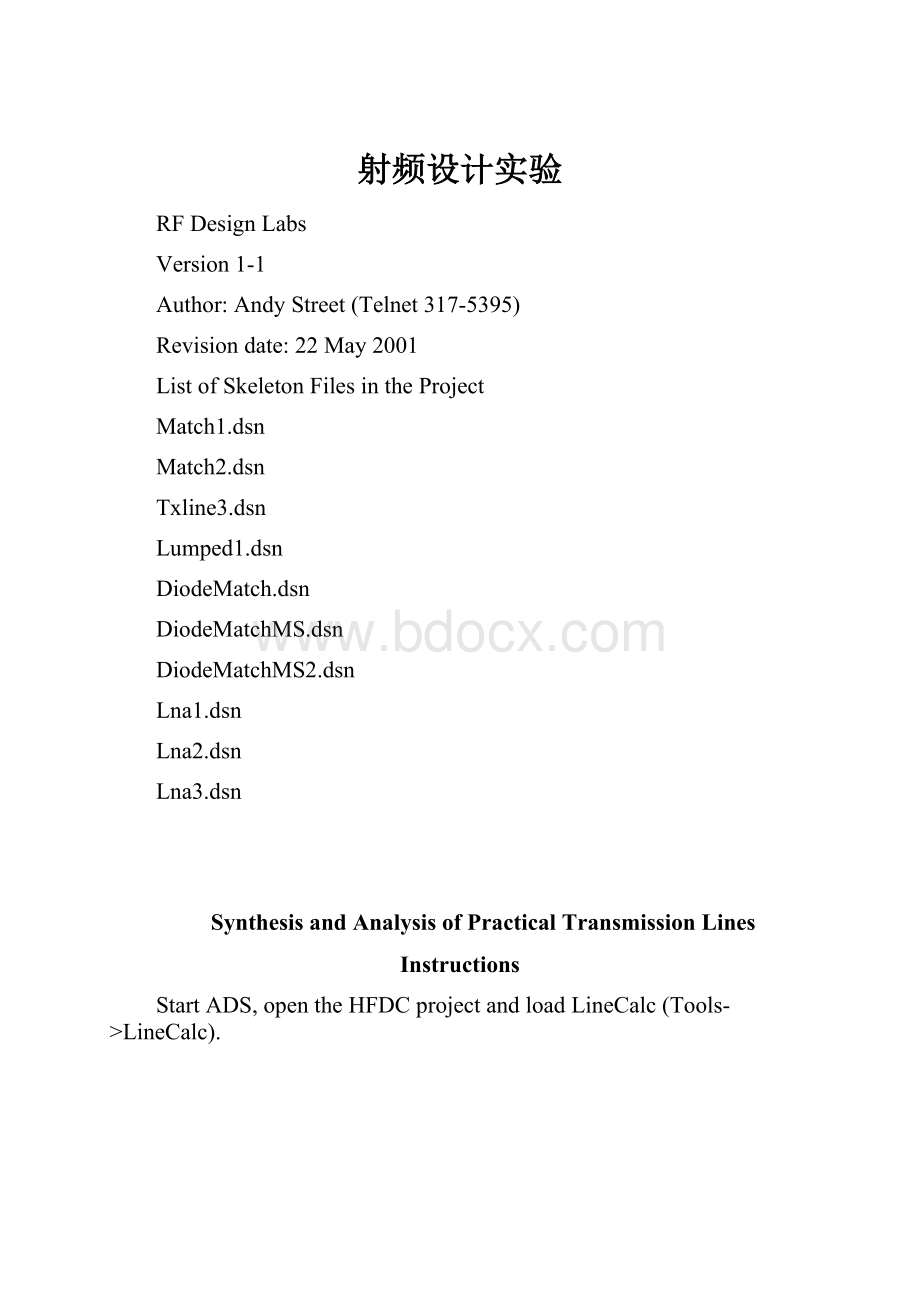射频设计实验.docx
《射频设计实验.docx》由会员分享,可在线阅读,更多相关《射频设计实验.docx(19页珍藏版)》请在冰豆网上搜索。

射频设计实验
RFDesignLabs
Version1-1
Author:
AndyStreet(Telnet317-5395)
Revisiondate:
22May2001
ListofSkeletonFilesintheProject
Match1.dsn
Match2.dsn
Txline3.dsn
Lumped1.dsn
DiodeMatch.dsn
DiodeMatchMS.dsn
DiodeMatchMS2.dsn
Lna1.dsn
Lna2.dsn
Lna3.dsn
SynthesisandAnalysisofPracticalTransmissionLines
Instructions
StartADS,opentheHFDCprojectandloadLineCalc(Tools->LineCalc).
Synthesis
Usingtheinformationgiveninthetablesbelow,calculatethephysicalparametersrequiredtorealisecharacteristicimpedancesof50ohmsand150ohmsandelectricallengthsof90O.Assumeanoperatingfrequencyof1GHzandthatalldimensionsareinmm.
TxLineType
Element
Parameters
50ohmline
150ohmline
Coaxial
COAX
r=2.2
DO=2.00
DI=0.58
DI=0.049
L=50.5
L=50.53
Coaxial
COAX
r=2.2
DO=10.00
DI=2.9
DI=0.244
L=50.5
L=50.53
Microstrip
MLIN
r=2.95
h=0.79
W=1.98
W=0.14
L=48.6
L=52.1
Microstrip
MLIN
r=10
h=0.635
W=0.59
W=0.0035
L=29.3
L=33.4
Stripline
SLIN
r=2.95
b=1.58
W=0.99
W=0.03
L=43.6
L=43.6
Notes:
Coax:
usedefaultparametersofTanD=0.02(losstangentofdielectric),Rho=1.00(resistivityrelativetocopper),sigma=0(surfaceroughness).EnsureDOisthefixedparameter.AlsoensurethatyourDIparameteris‘intheballpark’fortherequiredZO.
Microstrip:
usethefollowingparametersMur=1.0(relativepermeability),Hu=3.9e+34orsomeotherverylargenumber(heightofcover),T=17.5um(metallizationthickness),Cond=4.1e7(conductorconductivity),TanD=0.003(dielectriclosstangent),Rough=0(conductorsurfaceroughness).
Stripline:
usethefollowingparametersMur=1.0(relativepermeability),T=17.5um(metallizationthickness),Cond=5.8e7(conductorconductivity),TanD=0.003(dielectriclosstangent).
AnalysisofTransmissionLines
Assumethattheminimumrepeatablemicrostriplinewidthonaboardis0.15mm.Whatisthemaximumcharacteristicimpedance(ofthemicrostripline)thatcanbeimplementedonthefollowing:
R=2.95h=0.79mmt=17.5umZO=147.7
R=10.0h=0.635mmt=17.5umZO=82.1
InputImpedancetoaTransmissionLine
Openthefiletxline3.dsn.
InthisexercisewewillexaminetheinputimpedancetoatransmissionlineusingthetunefunctioninADSandtheSmithChartforthedisplayformat.Theschematicshowsaverysimplenetworkconsistingofa200ohmloadconnectedtotheinputterminal(thesource)viaanidealpieceoftransmissionline(anelectricalmodelwithnolossordispersionthatischaracterisedintermsofitscharacteristicimpedance,ZO,itselectricallength,E,andthefrequencyatwhichtheelectricallengthisisapplicable).Initiallytheschematicshowsthetransmissionlinewithzeroelectricallengthi.e.theloadiseffectivelyconnectedtotheinputport.Wewillsimulatethisnetworkatasinglefrequencyof1GHz(doubleclickontheS-parameterblockandnotethatthesweeptypeissettoSinglePoint).
∙Simulatethenetwork(Simulate->Simulate,orpressF7)
∙Openanewdatawindow(Window->NewDataDisplay)
∙PresstheSmithChartIconandplacethenewplotinthewhitearea
∙AddS(1,1)totheplot(thenpressokay)
IfyouexaminetheplotcarefullyyouwillseeasinglepointontherealaxisoftheSmithCharttotherightofthematchpoint.Verifythereflectioncoefficient(S11)andimpedanceatthispointusingamarker(Marker->Newandthenplacethemarkeratthedatapoint).ForclaritymovethemarkertextofftheSmithChartaxis.Verifythatthemarkershows:
S11=0.60Znorm=ZO(4+j0)
Nextwewillsetupthetunefunctionandadjusttheelectricallengthofthetransmissionlineandmonitortheinputimpedance.
∙Selectthetunefunction(Simulate->Tuning)
∙Whilstthecross-hairsarepresent,selecttheEvalueofthetransmissionline
∙Increasethetracehistoryto60andpress‘Details’tosetuptherangeoftuning.
∙IntheDetailsmenu,chooseMin=0,Max=360,StepSize=5,thenclick‘Brief’
∙Withthetunewindowanddatadisplaybothvisible,incrementtheelectricallengthofthetransmissionline.NotetheupdatedtraceontheSmithChart–wearetracingoutaconstantVSWRcirclei.e.themagnitudeofthereflectioncoefficientremainsconstantwhilstitsphasechanges.Notealsohowtheimpedancehasacapacitiveelementtoit,thenitbecomesentirelyreal,thenithasaninductiveelementtoit.
Atwhatelectricallengthistheinputimpedancetothelineatitsminimumresistivevalue?
90degrees
Howmanywavelengthsoftransmissionlinedoesittaketoreturntothestartingpoint(i.e.the200ohmpoint?
).180degrees
Finally,letuslookattheeffectofvaryingthelengthofthetransmissionlineontheinputimpedance.Todothiswewillneedtosetuptheelectricallengthofthetransmissionlineasavariableandthensweepthisvariable.
∙Toaddavariabletotheschematic:
Onthelefthandsidemenuchoose‘DataItem’.Fromthepalettechoose‘Vareqn’andplaceitontheschematic.Doubleclickontheboxtoedit.Inthe‘Name’boxreplace‘X’with‘elen’andinthe‘VariableValue’boxreplacethe‘1.0’with‘0’.Thenchooseclick‘Apply’,verifythatthechangehasbeenupdatedandthenclick‘Okay’.
∙Toreferencetheelectricallengthofthetransmissionlinetoourrecentlycreatedvariable,editthe‘E’entryforthetransmissionlinesuchthatitreads‘elen’(youcandothisontheschematic).
∙Toaddasweepcontroltosweeptheelectricallength:
fromthelefthandsidemenuchoose‘Opt/Stat/Yield’andselect‘PrmSwp’fromthepaletteandplacethesweepplanontheschematic.Doubleclickonthe‘PrmSwp’(ParameterSweep)boxtoedittheparameters.Underthe‘Sweep’tab,typein‘elen’astheparametertosweepandsetupthesweepasStart=0,Stop=360,Step-size=5.Underthe‘Simulations’tabtype‘SP1’inthe‘Simulations1’box–thissetsupthesimulatortoperformtheSP1simulation(S-parametersimulationatourfixedfrequencyof1GHz).
ChooseanewdatawindowandaddaCartesian(XY)plot.Forthedatatraceselect‘Z’(RealPart)Addvs.‘elen’.Repeattheprocessandchoose‘Z’(ImaginaryPart)Addvs.‘elen’.
Wenowhaveaplotofinputimpedancevs.electricallength.
Whatisthemaximumresistancevalue?
200ohms
Atwhatpointsistheinputimpedanceamaximumpureresistance?
nx180deg
Whatistheminimumresistancevalue?
12.5ohms
Atwhatpointsistheinputimpedanceaminimumpureresistance?
90+nx180
Istherearelationshipbetweenthemaximumandminimumresistancevalues?
Yes,whenthelinelengthis90degrees,wehaveaquarterwavetransformer.Recall:
ElementParasitics
Asdiscussedduringthecourse,lumpedelementshaveparasiticsassociatedwiththem,precludingtheiruseathigherfrequencies.Inthefollowingexerciseweshalllookatasurfacemountinductorandexaminehowtheparasiticelementsaffectthecomponentperformance.
Openlumped1.dsn
Inthisschematic,wehaveonecircuitwhichisalibrarymodelofasurfacemountinductor,whilsttheotherisanapproximategenericmodeloftheinductor.(Theseriesresistancemodelsthelosses,whilstthecapacitanceaccountsfortheparasiticcapacitanceassociatedwiththepackage).Termination1(TERM#1)isconnectedtothelumpedelementmodelwhilstTermination2(TERM#2)isconnectedtothelibrarycomponent.Thus,inthesimulation,S11willrefertothereflectioncoefficientofthelumpedelementmodel,whilstS22willrefertothereflectioncoefficientofthelibraryelement.
Simulatethecircuit(Simulate->Simulate)andthenopenaresultswindow(Window->OpenDataDisplayandthenchooselumped.dds).
Examinetheplots:
∙TopXYplotshowsthereturnlossvs.frequency.Theplotsarebroadlysimilaruptoabout1GHz(apartfromtheverylowfrequencypoints–thisbeingduetothemodelhavingnolossmechanism).
∙MiddleXYplotshowsthephaseofthereturnloss.Itisevidentthatthereissomediscrepancybetweenthe‘ideal’inductor(ourmodelwhichfornowonlyincludesaninductanceterm)andthelibrarymodel.
∙BottomXYplotshows‘inductanceversusfrequency’.Theinputimpedanceisoftheform:
Sothattheimaginarypartisgivenby:
Thus,dividingby2fgivestheapparentinductance.
Againweseediscrepancybetweentheidealandlibrarybasedcircuits.Finally,theSmithChartshowstheinputimpedanceofbothcircuits.Bothfollowthe50ohmcircleofconstantresistance,butthephaseofthelibrarymodelincreasesmorequicklywithfrequency.
Now,letsusethe‘Tune’functiontoseeifwecandeterminevaluesforRandCinourmodel.Inthecircuitschematicwindow,selecttheRcomponentandthenselecttune(Simulate->Tuning).Apop-upboxappearswiththeparametersassociatedwithR(namelytheresistance!
).Clickonthedetailsbuttonandchange‘TraceHistory’settingto0(i.e.itwillnotkeeptunedplotsonourdisplay).Changethe‘StepSize’entryto0.05(thiswillallowincrementsin0.05ohmsteps).Withtheresultwindowclearlyinview,incrementtheresistancevalueuntilyougetagoodmatchbetweenthelowfrequencyperformanceofthelibraryandmodelcircuits.Whenyouaresatisfied,clickonthe‘Update’button–thiswillupdatethevalueintheschematic.
Withthetuningwindowstillopen,selectthecapacitorfromtheschematic.Performasimilarprocessoftuningthecapacitor.Suggestedstepsizeis0.01pF.
Whatistheseriesresistanceofyourmodel:
0.4ohms
Whatistheparasiticcapacitanceinyourmodel:
0.29pF
NowadjusttheSparameterblock(doubleclickontheSParameterblock)andincreasethestopfrequencyto8GHz.Examinetheresultsnow.Aboveacertainfrequencytheinductorbecomescapacitive!
Whatisthefrequencyatwhichtheind